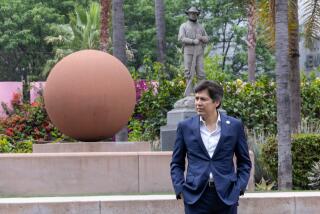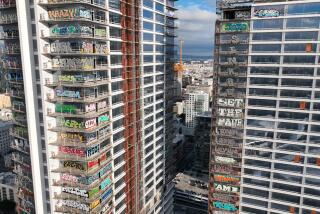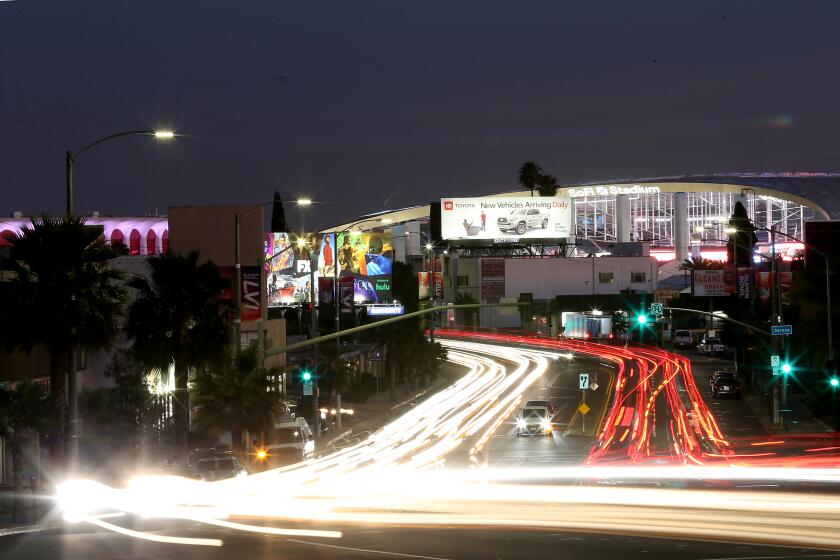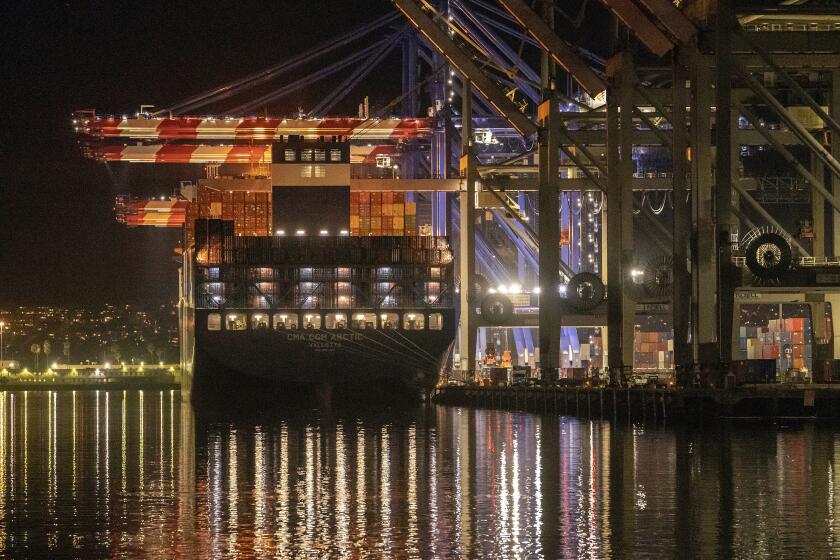Column: Developer Wayne Ratkovich on revitalizing L.A.’s historic buildings
One of the symbols on Los Angeles’ official city seal is a stylized castle. Maybe it should appear with a wrecking ball hanging over it. Raze first, ask questions later has often been the drill with historic buildings. But the city, working with the Getty Conservation Institute, has crafted a website of historical resources, HistoricPlacesLA.org, to inventory sites of “rich social significance” and alert public and private interests to their existence. One man who’s been tracking them all along is Wayne Ratkovich, an advisor to the project. His development firm has been one step ahead of the wrecking ball in some cases, polishing tarnished architectural jewels into landmark status. Instead of resisting historic designation, he’s made a specialty, and his reputation, out of it.
Aren’t landmarks impediments to development?
In the mid ‘80s, developers and preservationists were almost at war with each other, developers claiming property rights and preservationists saying, “This is the heart of our city.” Now you see groups like the Urban Land Institute, the National Trust for Historic Preservation and developers working together. HistoricPlacesLA is a step in the same direction. It says, “These are the things we value in our city; come bring them back to life if they need it, and if you’re thinking about demolishing them, you might want to look at other places, because this is something we treasure.”
Why do you go to the trouble of rehabbing old buildings?
We’d like to be an example of capitalism in its most admirable form. We function in the private market, not with government subsidies, and we fulfill our mission to profitably produce developments that improve the quality of urban life. That allows us to do well and do good at the same time.
What was your first historic building?
In the 1970s, I began to buy buildings. One day a listing arrived on my desk. It was the Oviatt Building — 100,000 square feet on Olive Street for $400,000 or $500,000. I figured we ought to be able to do something with that.
The Oviatt building is a treasure — originally a swanky haberdashery and the biggest commercial project French art glass maker Rene Lalique ever undertook.
I didn’t know who Rene Lalique was at the time. I didn’t know who Oviatt was. A representative of the city came to our office and said, “Congratulations on your cultural historical landmark.” We didn’t know whether that was good or bad. We were pretty quick learners. We began to understand the significance of the building, its history, its architecture, what Art Deco was. The response [to the rehab] was remarkable. We thought, “What is going on here?”
What was going on?
History. People appreciate history, they appreciate good design, so we said, “That’s what we’re going to market.” And it worked. Three years after we bought it, we got an offer far beyond anything we ever imagined.
We didn’t have to look too far [for more projects]. Then-Councilman John Ferraro called me and said, “Will you please go buy the Wiltern Theatre? The preservationists are driving me crazy.” So we bought it and the Fine Arts Building [on 7th Street, between Figueroa and Flower], and other opportunities began to come to us, and they still do. Like the 11 Howard Hughes buildings [one-time property of Hughes Aircraft Co., at Playa Vista]. A lot of people shy away from older buildings, from historical designations — that’s good for us!
Have you changed investors’ minds about such projects?
There’s much more interest. The Howard Hughes buildings were in terrible shape. We were able to attract the capital but the field was pretty narrow. [But] once we finished the job, everyone was interested in it. We paid about $60 a square foot, 575,000 square feet on 28 acres in West Los Angeles, and now, four or five years later, the finished buildings are selling for $600 a square foot. We had to spend money, but you can go from $60 and spend a lot and still [make money].
You were born in South Gate and grew up in Alhambra and Hacienda Heights — a pretty rural life. When did you first get to the big city?
My first trip to New York was probably the awakening. In 1970, ‘71, I was a real estate broker. I had a meeting with Mobil Oil, and I didn’t know New York at all. I knew I needed 45 minutes to get from L.A. to Century City, so I assumed I needed 45 minutes to get to [the Mobil] headquarters in New York. I got in a cab and said, I’d like to go to this address, and he said, “For God’s sake, it’s right across the street!” I began to think how convenient and interesting a city can be.
Why does Los Angeles have such a bad track record when it comes to saving its own history?
It’s a place of rapid growth and short memories. In the first 50 years of the 20th century, downtown Los Angeles was the center of commerce, of government, of retailing and entertainment. Then we had 50 years of urban expansion. There was a time when “urban” was a dirty word. Now we’re back saying cities are pretty good places.
The Los Angeles Conservancy had its first public meeting in the Oviatt — maybe 50 people. Now it’s the largest preservation organization in the country, I think. Sally Stewart, one of the founders of the Conservancy, said to me, “We’re not really interested in preserving buildings just to be museums; we’re interested in preserving buildings to have a new life.” That’s the right approach.
Can Bunker Hill ever be reintegrated into the city?
They should have left it alone: 155 acres that the city condemned and I don’t think it’s ever going to work out now. I say this as an owner of an office building on the flatlands, so I’m biased, but the truth is, people want to move out of Bunker Hill and come down here to be a part of the real city.
[Decades ago], the city leaders said, “We’re about to become the second-biggest city in the country and we don’t have a skyline.” In my opinion [the skyline] should have been along Wilshire Boulevard, the great linear downtown in America.
You must have seen the wrecking ball take down things you wish it hadn’t.
The Richfield Building [demolished in 1969] — that’s the first thing that comes to mind. Such a singular building, such an extraordinary building. I think I could have done something with that.
Pershing Square has a huge footprint in downtown, but nobody likes it. You presided over one competition to rehab it. Nothing’s really worked. Why is it such a hard nut to crack?
A lot has to do with the fact that it’s a parking structure, that it’s sitting on top of cement. It’s just an awkward site. One of the great places in America is Bryant Park in New York. It used to be terrible, but now it’s a park, a library, you have restaurants, a merry-go-round, and at Christmas they fill it with pop-up shops. It kind of pays for itself. That’s a wonderful example of what might happen at Pershing Square. There’s got to be a good solution.
The city tapped you to make over Ports O’Call in San Pedro — I’m tempted to say poor ol’ Ports O’ Call.
It’s really challenging. The city has a rule that you can’t lease the property for more than 50 years. You get about halfway through that and no one’s going to put five cents into the property because they’re going to lose it in 25 years. So it begins a gradual decline, and that’s the condition it’s in right now. It’s an opportunity for restaurants along the waterfront, [another] Bryant Park.
I wore this vintage L.A. tourist scarf today, with images of the Hollywood Bowl, Olvera Street, Grauman’s Chinese Theater. If you were designing such a scarf today, what would be on it?
My version would have to be a blanket! For starters: Disney Hall, Staples Center, Farmers Market, Langer’s, Philippe’s and Cole’s, the Santa Monica Pier, the Hollywood sign, the USC and UCLA campuses, the Bradbury Building, Grand Central Market … You just got me started!
This interview has been edited and condensed.
Twitter: @pattmlatimes
Follow the Opinion section on Twitter @latimesopinion and Facebook
More to Read
A cure for the common opinion
Get thought-provoking perspectives with our weekly newsletter.
You may occasionally receive promotional content from the Los Angeles Times.







